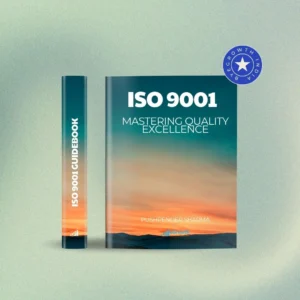No products added!
Category
Date Posted
February 13, 2024
/
0 Comment
Navigating ISO 9001: A Step-by-Step Guide
Unlock the secrets to a successful ISO 9001 journey.
Quality management is at the heart of every successful organisation. In the pursuit of excellence, many organisations turn to ISO 9001, a globally recognised standard that sets the foundation for effective quality management systems.
Despite the standard’s debut in 1987, there remains a pervasive challenge: many organisations have yet to grasp the nuances of implementing ISO 9001 fully.
In this comprehensive blog, we will navigate the intricate steps of ISO 9001 implementation, offering practical insights and tips to steer your organisation toward success. Whether you’re a seasoned professional or a newcomer to the world of quality management, this step-by-step guide aims to demystify the process, making your ISO 9001 journey not only manageable but rewarding.
“ISO 9001 not only ensures the delivery of high-quality products and services but also enhances overall organisational efficiency.”
Understanding ISO 9001
ISO 9001 is an internationally recognised standard that sets out the criteria for a quality management system. It provides a framework for organisations to ensure that their processes meet the needs of customers and stakeholders.
Its primary goal is to help organisations consistently meet the needs of their customers and stakeholders while complying with statutory and regulatory requirements. Its significance lies in its ability to enhance customer satisfaction, improve processes, and drive overall efficiency within organisations.
The key principles of ISO 9001 include a strong customer focus, leadership engagement, a process approach, and continual improvement.
Stages of ISO 9001 Implementation
Stage 01: Preparation & Planning
Gap Analysis
The first step involves a comprehensive Gap Analysis, which involves evaluating an organisation’s current processes against the stringent requirements outlined in ISO 9001. By discerning the gaps between existing practices and the expectations of the standard, we establish a foundation for targeted improvements.
This critical step not only identifies areas for enhancement but also propels the organization toward alignment with ISO 9001, fostering a culture of continuous improvement.
Team Selection
The next step is Team Selection, which plays a pivotal role in the successful implementation of quality management system. Top Management needs to formulate a team (at least one person from each department) consisting of members from different departments to capture diverse perspectives. This team will be the driving force behind the entire implementation process, bringing together expertise and insights.
Define scope of QMS
Defining the Scope of a Quality Management System (QMS) is a foundational step that outlines the boundaries and areas to which the system applies. It establishes clarity and aligns organisational objectives, guiding subsequent planning and implementation of quality processes within the defined parameters of its operations.
As required by the standard, the scope must be documented. While not mandatory to have a separate document, it can be effectively incorporated into existing documents such as the quality policy or quality management system manual.
Release of Quality Policy
Top management holds the responsibility of ensuring the establishment of a Quality Policy that accurately reflects the organisation’s intentions and commitments towards the Quality Management System (QMS). This policy serves as a foundational document, outlining the organisation’s overarching goals and principles related to quality management.
It will act as a guiding beacon, aligning the efforts of all stakeholders towards the achievement of quality objectives and continuous improvement within the organisation.
“Quality policy not only communicates the organisation’s dedication to quality but also sets the tone for the entire QMS implementation process.”
Stage 2: Awareness and Training
Awareness of ISO 9001 to Team
For the effective establishment and implementation of the system, the team must have an understanding of the requirements of the ISO 9001 standard. Creating awareness is key to this process. To achieve this, conduct informative sessions for all employees, emphasising the benefits and objectives of implementing the quality management system.
A well-informed team is essential for garnering support and fostering a culture of quality.
Refer link to ‘ISO 9001:2015 Internal Auditors Training Session‘
Internal Auditors Training Session
To assess the effectiveness, suitability, and adequacy of the established quality management system, the organisation must conduct an internal audit, as mandated by the ISO 9001 standard. It is imperative for selected employees to attain the competence necessary for conducting internal audits effectively.
Therefore, specialised training should be offered to individuals to ensure they acquire the required proficiency for this purpose.
Refer link to ‘ISO 9001:2015 Internal Auditors Training Session‘
Stage 3: Documentation and System Development
Apex Document Preparation
As a pivotal part of ISO 9001 implementation, the Apex Document Preparation involves crafting fundamental documents that serve as the backbone of your Quality Management System (QMS). This includes developing a comprehensive quality manual, quality system procedures, and related formats.
These documents address crucial aspects such as context of the organization, document and record control, address of risks and opportunities, planning to achieve objectives and targets, internal audit, management review, non-conformity and corrective action, and continual improvement. They collectively outline the expansive scope of the QMS, laying a robust foundation for adherence to ISO 9001 standards.
Departmental Document Preparation:
Simultaneously, the next step focuses on crafting department-specific procedures. Covering key areas like customer communication, design and development, selection and evaluation of external providers, control over production and service provisions, release of products, and control of non-conforming outputs, these documents are tailored to each department’s unique processes.
Meticulous documentation ensures alignment and consistency throughout the organization, fostering a unified approach to quality management.
Implementation of System:
With the documented system in place, the subsequent step is to seamlessly roll it out across the organization. This goes beyond information dissemination; it actively involves the collection of vital data and records related to processes, performance, and compliance.
This holistic approach ensures that the implemented system not only meets ISO 9001 stipulations but also contributes to the continuous enhancement of processes, reinforcing the organisation’s unwavering commitment to quality excellence.
Stage 4: Internal Audits and Management Review
Internal Audits
Prepare an internal audit plan and execute audits at defined intervals. Ensure objectivity and independence during the audit process to verify adherence to ISO 9001. Effectively communicate findings, be they non-conformities or areas for improvement, to the relevant parties. Conclude by reporting audit results to management as necessary.
This step is pivotal for refining processes and ensuring their alignment with ISO 9001 standards.
Management Review Meetings (MRM)
Conducting Management Review Meetings (MRM) at regular intervals is essential for the comprehensive evaluation of the Quality Management System (QMS). With management actively leading as chairpersons, these reviews align with ISO 9001 requirements, addressing crucial points from each department’s intended outcomes.
The agenda encompasses essential points reviewed by Top Management, and provides crucial insights and addresses identified gaps or improvement opportunities, prompting necessary actions by responsible department.
This dynamic process not only upholds QMS effectiveness but also reinforces the commitment to excellence, meeting evolving organisational needs and industry expectations.
Stage 5: Certification Readiness & Certification
Preparation for Certification Audit
In this stage, meticulously address findings identified during internal audits and Management Review Meetings (MRMs). Ensure all documentation is not only comprehensive but also current, setting the stage for a robust Certification Audit.
This step is integral to the preparation process, laying the foundation for a seamless evaluation.
Certification Audit
Initiate the Certification Audit by enlisting a reputable certification body to assess your ISO 9001 compliance. This is the defining moment where the effectiveness of your implemented Quality Management System is under scrutiny. Demonstrate its efficiency, marking the official recognition of your organisation’s unwavering commitment to quality excellence.
Stage 6: Ongoing Improvement
Continuous Improvement
Cultivate a workplace ethos dedicated to perpetual advancement. Harness insights from audits, reviews, and performance data to iteratively refine your processes. This steadfast commitment ensures the ongoing dynamism, adaptability, and alignment of your Quality Management System with the ever-evolving needs and expectations of your organization. Embracing a culture of continuous improvement positions your organization for sustained excellence in quality management.
Conclusion
Embarking on the ISO 9001 journey is a strategic decision that positions your organisation for sustained success. By following this step-by-step guide, you’re not just meeting a standard; you’re fostering a culture of quality and excellence.
As you implement ISO 9001, remember that it’s not a one-time project but an ongoing commitment to improvement. Your ISO 9001 journey is a continual process of refinement, adaptation, and growth, ensuring your organization stays at the forefront of quality management.
References
- Book by eGrowth – Mastering Implementation of ISO 9001
- Refer Course Menu for various training related to ISO 9001 or Quality Management
ISO 9001 is notaone-size-fits-allsolution;rather, it provides a flexible framework that can be adapted to various industries and organisational sizes.
Tags :
500



